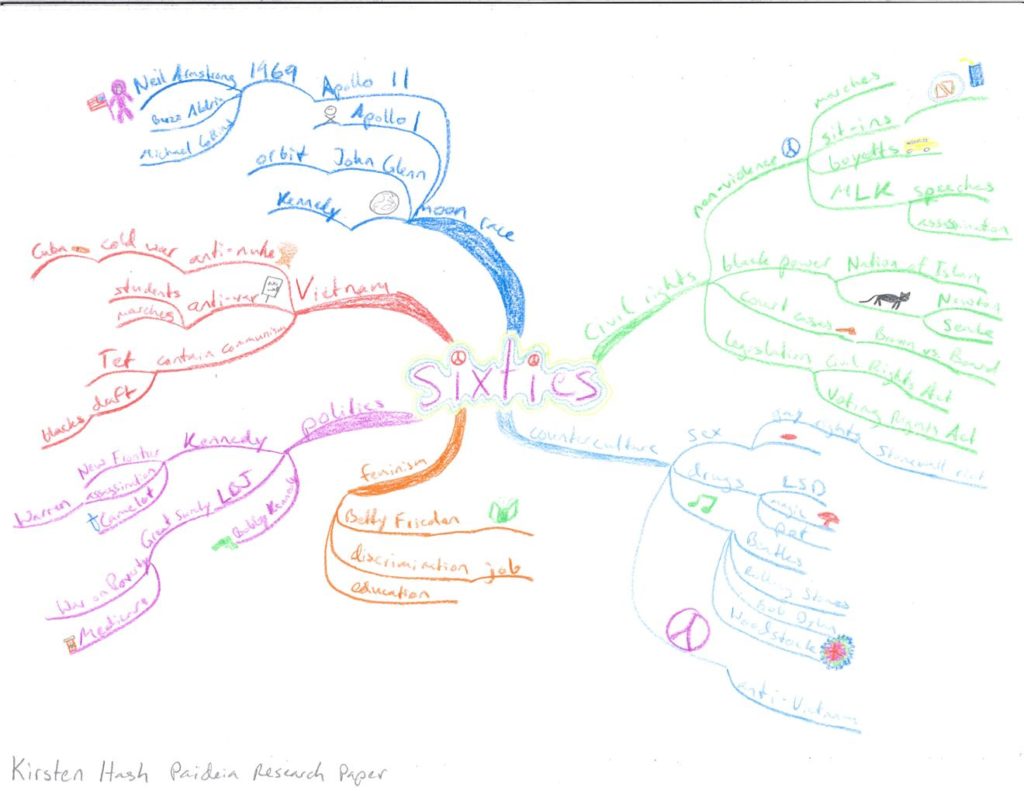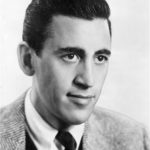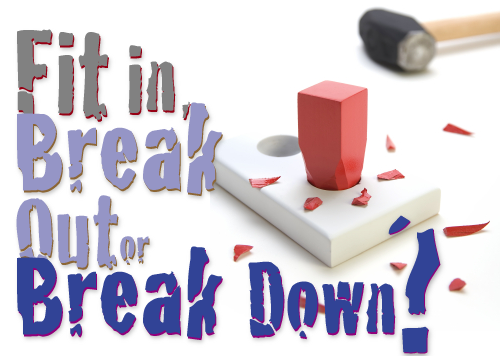Version 1
Version 2
Introduction
(This would be presented as an in-person activity – the text provides the main perspective, but the session is more interactive and focused on the students’ reactions)
What happens when your experience of life doesn’t match up to the way you thought it would go? Think about this in terms of making friends in a new school, neighbourhood or job. You walk in, start meeting people and get some feedback that this isn’t quite what you expected. Maybe you smile and people are grumpy. Maybe you make a funny comment and no one laughs. It could be that the people around you expect you to already know something and you don’t. How will you react?
The field of psychology suggests that if you feel external pressure to behave in a certain way, you will either conform or rebel (resist authority, control, or convention).
Imagine that you are a person of very strong feelings and beliefs and then not only a job or group of friends makes you feel like you don’t fit in, but your whole society does. You feel like something of a misfit or outcast. What would you do? What will you do?!
This WebQuest asks you to explore the era of the 1950s through actual video footage from the decade. Then you will focus on a specific person or movement who chose not to conform, to rebel. This often included great personal cost and suffering and sometimes resulted in great art or social change. Sometimes it ended badly for the person and sometimes they lived a long and happy life.
By engaging in this exploration, the main focus will be for you to look within your own ideas, values and feelings to connect with the main question on a personal level and to gain deeper understanding of how social pressures and individual choices can be expressed in a range of ways so that you are better prepared to succeed in the life you envision.
Make a Choice
In this Unit on “The Rebel” you can choose your path or invent your own. Besides the work that will be done in class and the follow-on assignments, you have the opportunity to further explore an areas that interests you.
The following activity gives you the chance to connect with and appreciate the culture surrounding the two core texts in a way that is personally meaningful and rewarding. All the links below touch on the world in which James Dean and J. D. Salinger lived. Obviously their personal experiences influenced the core texts Rebel Without a Cause and The Catcher in the Rye. To get to the heart of these works and relate them to your own life, we will consider the nature of conformity & rebellion and their relationship to success & psychosis.
The Quest(ion)
Fit in, break out or break down?
When people are confronted by cultural pressures, they can conform or rebel. Each comes at a cost. As sensitive and creative people, artists often brave the norms to invent new ways of living, finding meaning and expressing themselves.
By exploring cultural icons from 1950s America, you can gain insights into how you might make a life for yourself in an era that is just as turbulent.
Level 1: Background for Everyone
Download the Level 1 Worksheet
Before you get into exploring the creative responses people had to the culture of the 1950s, it’s useful to immerse yourself in what life was like.
Here’s a good overview of the 1940s & 1950s and The American Dream by Al Jazeera
What’s the least you need to know to better appreciate Rebel Without a Cause and The Catcher in the Rye? How about this cheatsheet?
New Subcultures in the 1950s – Quick Immersion
If you are not going to participate in next section (Perspectives) of the full activity, at least make yourself familiar with the Wikipedia entry and videos below. This will give you an idea of some of the issues that dominated life in the 1950s. Use this Background Worksheet and the CEQ•ALL Rubric to guide your learning.
Explore some of the subcultures that emerged or developed in the 1950s…
- The Car Culture (illegal street racing & the Future car)
- The Cold War (Background)
- “Teenagers” (Peers & Dancing)
- The Beat Generation & Abstract Art
- Television & The Movies (Vertigo, From Here to Eternity & Forbidden Planet )
- Civil Rights Movement (Little Rock, Montgomery Bus Boycott / MLK) & Women’s Rights (1950s Educational Videos: Working with Women & Marriage Preparation)
- Eastern Religions / DT Suzuki & Zen Monastery
Level 1: Show Your Learning
 Besides completing the required Level 1 Worksheet, you might choose to collect what you have learned from a Quick Immersion in a Mind Map, bulleted list, collage, etc. Address the basics of “Who, What, Where, When, Why & How” and focus on pressures for Conformity and ways that Rebellion was expressed.
Besides completing the required Level 1 Worksheet, you might choose to collect what you have learned from a Quick Immersion in a Mind Map, bulleted list, collage, etc. Address the basics of “Who, What, Where, When, Why & How” and focus on pressures for Conformity and ways that Rebellion was expressed.
Level 2: Deeper Expertise
If you want to learn more, get in a team of peers (5 or 10 depending on whether you work in pairs) so that you can develop expertise on more specific aspects of life in the 1950s. The links below are organised into 5 main categories (thus the 5 or 10 group members). You should pick a category that interests you generally right now so that you can see what was happening in that field more half a century ago. Use the “Expert Questions” to guide your learning, then you will combine what you have learned with your other team members.
Links / Support Resources
- You can manage your learning with the CEQ•ALL (“Seek All”) Self-learning Rubric.
- There is an online space that you can join to work through Literature Circles and this activity.
- Download the Expert Group Questions
Popular Culture & Sport
- Movie Stars / Marilyn Monroe, Marlon Brando
- Movie Stars’ milestones: Grace Kelly marries, Humphrey Bogart wins Oscar
- TV Shows: Howdy Doody, I Love Lucy
- Game Shows: What’s My Line? (Dali), The $64,000 Question
- Le Mans & Grand Prix
- Sport / Jackie Robinson, 1957 World Land Speed Record
- 1956 Olympics in Melbourne / Women’s High Jump, John Landy helps Ron Clarke
- Hank Aaron, Mickey Mantle
“Modern Life” & Technology
- The “Mod Cons” & Modern Life & The Monsanto House of the Future
- Television (Leave it to Beaver, The Jetson’s)
- Portable Music / The 45 RPM
- Toys (Frisbee, Barbie)
- The Car (Design for Dreaming – General Motors)
- The Interstate Highway System
- Air travel
- Supersonic flight / Sputnik
- Dr. Jonas Salk / vaccine for polio
- Drugs – LSD (“experiment with Housewife”)
- Education: Doctor Spock speaks with Jackie Kennedy
Communism & The Cold War
- Rosenberg Trial
- The Cold War (Background)
- Nikita Khrushchev / The Soviet Union
- McCarthy & Anti-Communism (Cartoonist Herblock on McCarthyism)
- The Bomb (and death of Albert Einstein)
- Duck and Cover
- Newsreel – War or Peace 1950?
- The Korean Conflict
- Harry Truman
- Dwight “Ike” Eisenhower
Music & The Visual Arts
- Jazz / Cool: Miles Davis, Bebop: Charlie Parker / Dizzy Gillespie
- Rock & Roll / Elvis Presley / Little Richard / The Big Bopper)
- Fringe music: Frank Zappa (50s Interview & performance & 90s + 70s concert)
- Jackson Pollock / Abstract Expressionism
- Illustration / Saul Steinberg & Charles Addams & Mad Magazine
- Architecture / Levittown & The Guggenheim
Literature & Poetry
- (Quotes by “Beats” about the Beat Generation)
- Gregory Corso reads “Marriage” (about Corso)
- Gary Snyder reads a poem (about Snyder)
- Allen Ginsberg reading poetry with William Buckley, “New Stanzas for Amazing Grace”
- Arthur Miller / Death of a Salesman, The Crucible
- Jack Kerouac’s “On the Road” read on The Tonight Show with Steve Allen
- Joseph Heller / Catch 22
- Truman Capote / Breakfast at Tiffany’s
- Ray Bradbury / Fahrenheit 451
Core Texts – Group Decision
Now we come to the two major works studied in this unit: Rebel Without a Cause and The Catcher in the Rye. The work you have done so far in this activity should have prepared you with a context of what aspects of life was like in 1950s America. Below are a few links specific to James Dean and J.D. Salinger. You will apply the same Expert Questions and see what you come up with.
 James Dean
James Dean
- Wikipedia entry on James Dean
- James Dean: Life and Career Documentary by Robert Altman
- James Dean: Born Cool (2002)
- Trailer for Rebel Without a Cause
- Text of original psychological work: Rebel Without a Cause
- Scenes from Rebel Without a Cause
- Photo of James Dean’s fatal crash
 J. D. Salinger
J. D. Salinger
- Wikipedia entry on J. D. Salinger
- New York Times Salinger archive
- Pencey Prep (Valley Forge Academy) from a classmate of Salinger’s
- Walking in Holden’s Footsteps (interactive map) + article
- A typical Salinger sighting
- Holden at 50 – The New Yorker
- PBS NewsHour report and Literary reflection on Catcher in the Rye after Salinger’s death
- Joyce Maynard speaks of her time with Salinger
- J. D. Salinger a Recluse? Well, Not to His Neighbors
- Remembrance of JD Salinger from a colleague at The New Yorker Magazine
- Religious Dimensions of Catcher in the Rye & life in Vermont
- Yale lecture on Franny & Zooey
 Bonus: A Twist of Lennon
Bonus: A Twist of Lennon
Because of the connections between his life and death with people such as James Dean and J. D. Salinger, the story of John Lennon presents us with a later example of how conformity / rebellion and psychosis / success played out in the America of the 1970s and 80s. Explore the links below and think about how artists you like relate to this complex intersection of Rebellion / Conformity and Success / Psychosis.
- Wikipedia entry on John Lennon
- The Real John Lennon (Part 1) – early years to mother’s death
- Making “Imagine“
- John & Yoko on the Dick Cavett Show
- CBS Walter Cronkite Report: John Lennon Shot
- Mark David Chapman: background, interview with Barbara Walters, interview with Larry King & M.D. Chapman’s biographer
- James Taylor on John Lennon (who is James Taylor? 1970)
Level 2: Show your Learning
Expert Group Questions
Level 3: Your Creative Expression
Extension and Enrichment – for the Joy of Creativity
Here are some Rebels who paid a price and others who could be called “winners.” If any of these people interest you, go ahead and look into them. If you have some other favorite rebels, go ahead and explore them.
“Losers”
|
“Winners”
|
One possibility is to create your own video that combines your passions with some aspect of the 1950s that caught your interest. Here are some videos you might want to draw from.
- Newsreels 1950 – 1959 (3 hours worth!)
- Video Intro of 1950s Suburbia: (Part 1/ Part 2) (1957)
- 1952 Day In The Life Of A 1950’s Small Town
You could make your version of a video like this 1 minute overview of the 1950s, but yours could present the REAL 1950s. Use a one minute segment from the movie above and change the voice over to include the attitudes of people / things you researched especially pointing out the theme of rebel / conform / the individual vs. society. Examples of possible student productions:
- Video history: Women in the 1950s (National History Fair)
- Student Project – Feminine Mystique
- Parody: “Women Know Your Limits”
- News report: Do a Re-make of a News program (with commercials)
- Commercial Hegemony (samples of real Ads 1950s & 60s)
- Non-video Illustration – The Catcher in the Rye
- ????
Let’s Go Viral!!

One Response to WebQuest on YOU, the 50s, Conformity & Rebellion